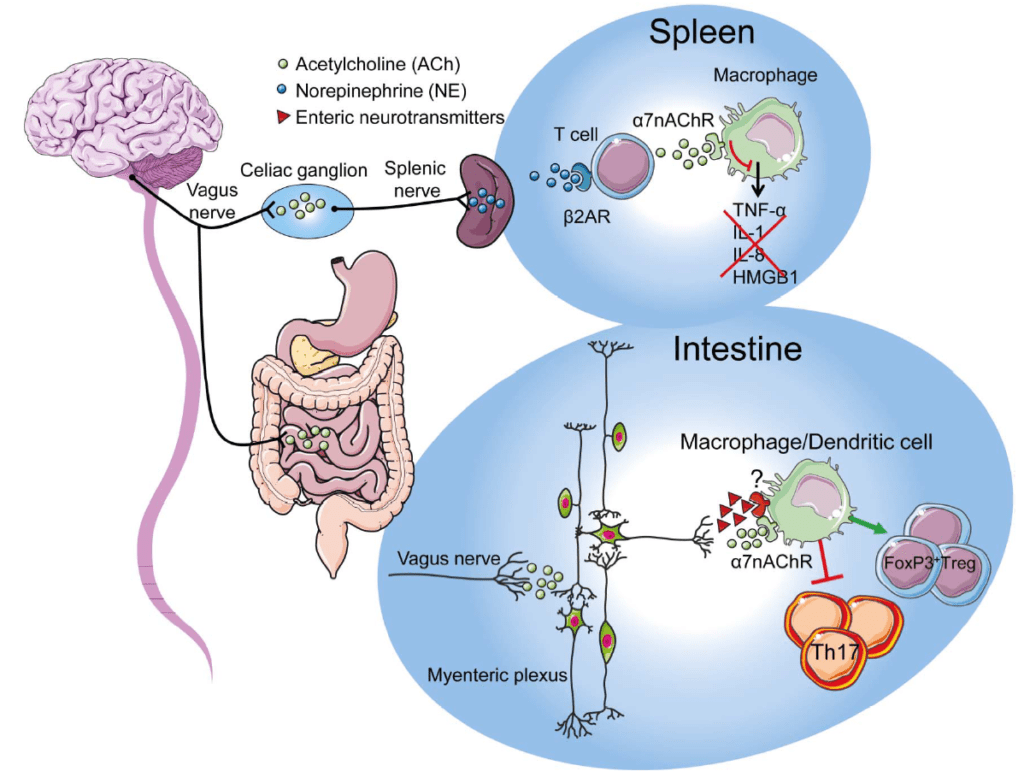The gut is back in fashion.
The gut with its microbiota (bugs), immune reactions and energy supply is increasingly attracting the attention from serious researchers and investors. For a long time, it was not really considered a ‘serious’ research area. Food and faeces were far too ‘everyday’ subjects for high inspiring scientists. I am happy to see that this has changed for the better. Now serious scientists cannot belittle the gut or its bacteria. A lot of start-ups’ and investments are now in the field of microbiome- and health food companies. As non-invasive blood sugar sensors improve, they also have a bright future. The gut is back in fashion 😊
The Vagus nerve is the ‘Gut Boss’.
Gastroparesis is a term for chronic problems when the stomach does not empty in the normal way. We all experience it occasionally but it is really debilitating when becoming chronic. This process of ‘emptying’ the stomach is a Vagus nerve motor function. If the Vagus nerve does not work properly, then the gut intestines muscle coordination is not working properly. It is a very demanding work to optimally move food along this more than 6 meters long pipeline. Most of us has experience from when the Vagus nerve is initiating and carrying out vomiting. This is a result of advanced Vagus data processing which all the time is calculating how good ‘homeostasis’ there is in the gut. When we for instance poison ourselves with too much alcohol, then the Vagus nerve estimates ‘out of range sickness response’ and gives an order to initiate muscles activity to get rid of the poison. And voila’ – we vomit. The belly muscles are controlled by the Vagus nerve and we know they can be extremely forceful when vomiting. Thanks to this and the Vagus, we usually don’t die from drinking too much alcohol at once. We all have heard the joke about ‘when body parts argued about who is the boss – the brain or the asshole?’ Well, it’s neither – it’s the Vagus nerve. 😊
Gut Microbiota
There are about 100000000000000 (1013) microbial cells in the gut and the intestines. These are mainly bacteria and there are ten times more of them than there are ‘of us’ (original human cells in our bodies). We should take good care of our friends but it is not always easy. This is because the microbiota composition is affected by a lot of factors, mainly the following:
- Diet
- Environment
- Antibiotics
- Aging
- Probiotics
- Exercise
- Mode of delivery (birth etc)
- Stress
- DNA
- Epigenetics
We know for instance that they are very sensitive to stress. Collectively they react to our ‘own’ stress a bit like a flock of starlings forming patterns in the sky. Very little is still known about this but enough for us to pay attention.
The Nerves
The gut nerves are collectively called the enteric nervous system (ENS). The ENS is so immense and ‘independent’ that it is considered the body’s 2nd brain. Traditionally it is listed as an extension of the autonomic nervous system network since it connects to the Vagus nerve – which is its pathway to the brain. Almost all gut signalling goes along it. Since signalling is both transferred and processed by the Vagus nerve, it is today considered as the most promising research area for ‘non digestible’ stimulation of the gut.
The Vagus nerve innervates all of the gastrointestinal tract and for instance the liver. Its sensory system spots the changes in metablolic molecules, micronutrients and gut wall expansion. If there is a sufficient homeostasis and physically enough food, the Vagus nerve sends a satiety signal to the brain and hopefully we listen and stop eating. If its sensor configuration is trained to be used to a lot of sugar-molecules, it tells the brain that ‘we need more sugar’.
Thousands of science papers and basic science show that the Vagus nerve plays a major role in the body’s reactions to food. It seems to be a kind of remote control for the gut. These reactions and the way we process food and release energy is an essential part of Vagal homeostasis (balance). One example is that the Vagus nerve is slowing down digestion when we are in ‘fight and flight’. When the body is stressed, digestion is less effective because the vagus nerve is ‘re-routing’ energy to other more urgent places that serve muscles and alertness. It also starts using more glycogen in the liver if there is not enough sugar coming from the stomach. It is not evolutionally wise to waste energy on digesting a sandwich while running away from a lion.
Stress and Chewing
The concept of stress is very important to understand when one is trying to improve gut function. We know that we should take our time and be mindful while eating. Remember that ‘time and mindful’ are synonymous with relaxation and activation of the Vagus nerve. Chewing is also not only about reducing the size of foodstuff – it is a form of Vagus stimulation. Many of our mothers told us to chew at least twenty times before swallowing. My mom though didn’t know that it was because it is good to stimulate the Vagus nerve when eating. Chewing is triggering a neurological vagal signal to the gut that puts it into higher ‘digestion’ alert mode before we are dumping food into it. A bit like switching ‘on’ the incinerator. Again – logical and brilliant 😊
Various types of stress can cause gut disease such as Crohns or IBS. Many autoimmune or chronic diseases are linked to some kind of gut dysfunction. This stress, which is caused by disease (bacteria or virus), can trigger a fatal downward spiral in gut functionality. The ‘badly functioning’ gut is then preventing normal immune improvements and potentially triggering autoimmune reactions. The cause and effects are different in different diseases, but it is a fact that low vagal tone is almost always comorbid with some kind of gut problem.
To fix many chronic diseases one first has to ensure that the gut health is in order. Bad food habits destroy many medical- or other types health interventions. It is time to fix this root cause and improve the Vagus nerve functionality – while at the same time paying close attention to our gut health. We know that pills usually only temporarily change the molecular composition in the gut and it is seldom a solution to the ‘root’ cause. More often it is detrimental to the Vagus nerve and therefore causing many side effects and long term problems.
Diaphragm
The easiest self-help method for improving both gut functionality and Vagus nerve health, is diaphragmatic controlled breathing. The diaphragm muscle is of central importance not only for breathing and heart activity but also for the gut functionality. The diaphragm is the pump for the lymph in the belly and a ‘crusher and mover of foodstuff’. Proper lower chest breathing is important for proper lymph circulation and food movement in the stomach. The lymph circulation is necessary for the ‘waste disposal’ in our whole body. Toxins and waste products need to be removed quickly and properly for instance from the brain.
When we detect dysfunctional diaphragmatic breathing with the VAGUS® ECG test, people often have gut problems, fatigue and other symptoms. This is partly due to the lack of proper lymphatic ‘pumping’ functionality. I also want to remind that the lymphatic system is very important for immune cell distribution in the body so the better lymphatic circulation, the better our immune system is working. This is really important especially during these COVID-19 and Long COVID times.
I for instance personally get help for my reflux by doing deep diaphragmatic breathing. By breathing 5 seconds inhale / 5 seconds exhale while gently pressing my fingers under the lowest ribs, I can release acid ‘storm’ and sleep better. I also want to remind the readers about my blog on breathing. There I describe how modern life has severely damaged our skill to breath and especially breath longer breaths. We hence have less diaphragmatic movement which is affecting our gut health. (https://vagus.co/breathing-and-the-vagus-nerve/)
Sugar
Among its many important functions, the Vagus nerve is known as the neuro-plastic nervous system. This means that the Vagus nerve needs be reasonably active for the brain to form, strengthen or prune synaptic pathways. We cannot for instance learn anything if we are in full ‘fight-or-flight’ activation and Vagal tone is low.
The Vagus nerve regulates metabolic homeostasis by adjusting most of the internal organ functions. In addition to sugar absorption from the gut, it continuously adjusts glucose production in the liver. Thereby it plays an important role in the sugar balance and diabetes since it is adjusting liver glucose storage and endogenous (the body’s own) glucose production.
The taste of sugar is one of the most basic sensory precepts for humans. When eating sugar, we activate the Vagus nerve gut-to-brain post-digestive sugar-sensing pathway. This pathway is critical for the development of sugar preference. As the Vagus nerve it also very good at doing the above-mentioned plasticity on itself, the more sugar we consume, the stronger this pathway becomes. When it becomes strong, the more difficult it becomes too ‘satiate’ it. The other gut pathways might signal ‘happy and full’ but as long as the sugar sensing pathway is not satisfied, brain interprets the signals from the gut as ‘I need more sugar’.
Obesity
This same functionality also works well on fats or the general amount of food. If gut lining sensor pathways are ‘used to’ and require enough expansion, then a person needs to volume-wise eat a lot before the Vagus nerve signals ‘I’m full’ to the brain. It’s basically just signal mathematics. The more cables – the stronger signal it needs. Unfortunately, our frontal cortex is very dumb compared to the Vagus nerve. We cannot handle a lot of information simultaneously and we are really bad at recognizing ‘cause-effect’ in things like this. This is one of the reasons we really need objective data so my team has developed the Vagus® ECG test to help the frontal cortex. 😊.
Poor functional Vagus nerve can drive the development of obesity. The Vagus nerve activity levels are often good early warning signals for diabetes3. Metabolic homeostasis control can be harmed by non-gut reasons. Obesity can therefore have many causes – a bit like chicken and egg. If this happens, then for instance Vagus stimulation can be used. The aim is to improve Vagus nerve activity levels and thereby metabolic regulation. Studies have shown that Vagus nerve stimulation can work to reduce obesity and commercial products are being developed. Alternatively chronic obesity has functionally harmed the Vagus nerve and Vagus nerve stimulation can help to restore it.
VAGUS® ECG test users with obesity have on average lower VHI (Vagus Health Index) and other vagal tone indicators compared to our ‘normal weight’ clients. Vagal tone is generally low in obese people and it is an important indicator for low metabolic activity and/or obesity induced inflammations. Vagus Stimulation in type 2 diabetes is now trialled to improve glucose and insulin regulation. The purpose is regulation of vagal nerve afferents to allow better glycaemic control and potentially reduce the need for pharmaceuticals. We are happy to facilitate trials for food- and supplements effects on the VAGUS® nerve.
Immune system
I have described the Vagus nerve ‘cholinergic immune system’ in my earlier blogs about inflammation and the Vagus nerve: (https://vagus.co/inflammation-exercise-and-the-vagus-nerve-cholinergic-immune-system/)
I below include a good graphical description for those who are interested in more detail on how Vagus nerve immunity works in relation to the gut.
Pre-notice: I am currently wearing a ‘Supersapiens‘ blood sugar level sensor. I am comparing its data with the VAGUS ECG vagal tones and I am finding interesting correlations for instance between ‘fight-and-flight’ activation and sugar levels. I’ll blog about it next week and I’ll hold a room about the results. ‘Stay tuned’.
Have a great day, be mindful and remember to chew ten times when you eat your salad 😊
Gustaf
The Cholinergic Immune System innervation of the gut:

Picture from ‘Vagal innervation of the gut and immune homeostasis, Matteoli et al. 2012’
Some other interesting articles:
- ‘Gut Microbe to Brain Signaling: What Happens in Vagus…, Neuron 2018, Fulling Dinan et al.’
- Early Detection of Hypoglycemia in Type 1 Diabetes Using Heart Rate Variability Measured by a Wearable Device, Bekkink et al, Diabetes Care 2019
© Gustaf Kranck

